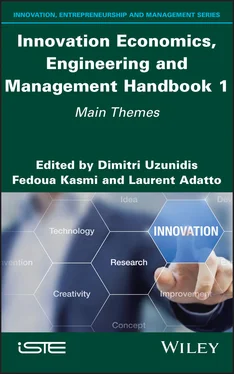Mendras, H. (1970). La fin des paysans. Innovations et changement dans l’agriculture française . Armand Colin, Paris.
Ricardo, D. (1817). On the Principles of Political Economy and Taxation . John Murray, London.
Temple, L., Chiffoleau, Y., Touzard, J.M. (2018). Une histoire de l’innovation et de ses usages dans l’agriculture. In Innovation et développement dans les systèmes agricoles et alimentaires , Faure, G., Chiffoleau, Y., Goulet, F., Temple, L., Touzard, J.M. (eds). Éditions Quæ, Versailles.
Touzard, J.M., Temple, L., Faure, G., Triomphe, B. (2014). Systèmes d’innovation et communautés de connaissances dans le secteur agricole et agroalimentaire. Innovations , 43, 13–38.
Vanloqueren, G. and Baret, P.V. (2009). How agricultural research systems shape a technological regime that develops genetic engineering but locks out agroecological innovations. Research Policy , 38(6), 971–983.
Chapter written by Ludovic TEMPLE.
4
Anthropology – Anthropological Aspects of Innovation: Defining Benchmarks
4.1. Introduction
In purely academic terms, which is only one criterion among others, innovation is not an anthropological theme. And yet, through the observation of techniques and material culture, anthropology deals with the question of innovations, as authors such as Robert Creswell, Bruno Latour, Pierre Lemonnier, André Leroy-Gourhan, Daniel Miller, Marcel Mauss, François Sigaut or Jean Pierre Warnier have shown. Through the explanations it provides on the problematic links between objects, tools, know-how, humans and their imagination, it produces the intellectual tools that will allow us to understand how new technologies are transforming all societies, whether they are “archaic” or “modern”.
In 1914, Bronislaw Malinowski, a Polish anthropologist exiled in England, was sent by his university to New Guinea. Because of the advent of World War I, he became stranded in the Trobriand archipelago, in the Pacific Ocean, where he unexpectedly set up an investigation. The location of the investigation was chosen according to the opportunities and constraints of access to the field. Improvising a survey in the face of the emergence of an unexpected change or innovation represented the first and foremost skill of the anthropology of innovation. Its objective is to understand the social logic of both the production of innovations and of their dissemination using a specifically anthropological method.
In 1922, Malinowski published his famous work, Argonauts of the Western Pacific , which describes the kula , a system of gifts and counter-gifts, based on shells, both utilitarian and symbolic, which circulate within the Trobriand society. Thanks to this field research, he introduced a methodological innovation whose effects were felt all the way up to “design thinking”, one of the approaches that is used today by designers to understand the processes of innovation, focusing on the experience of populations, on their daily lives, on their practices. At the starting point, the researcher masters nothing. They start without any preconceived ideas, i.e. without any hypothesis on the substance of the innovation or change they are going to investigate. In the course of the fieldwork, depending on the evolution of the phenomenon, they will be able to change the angle of observation, in contrast to, say, quantitative surveys by questionnaire, where it is not possible to change the questions during the course of the survey. It is a situation that we find when approaching an “exotic” country with an unknown culture, a new situation such as that of the lockdown linked to COVID-19, or when we have to talk about the future, i.e. an uncertain and unpredictable and somehow exotic world.
Malinowski’s investigation can be considered as one of the first to use an inductive method, i.e. an in vivo method, anchored in real life where nothing is under control, in contrast to in vitro laboratory investigations, where everything is under control in order to search for an independent causal variable. In anthropological investigations, the universes observed are made of stability and instability. The second characteristic of the anthropology of innovation is to know how to create reference points in an unknown and shifting world, thanks to the observation and description of what emerges, without knowing where it will lead the researcher.
4.2. Innovation, a total social phenomenon, between invention, diffusion and reception
Induction does not mean that the survey is methodless. Anthropology approaches the question of novelty as a “total social fact”, which includes the utilitarian and the imaginary, to use the expression of the anthropologist Marcel Mauss in The Gift (1925). This means that anthropology is not limited to the technical dimension of innovation. It shows that technical rationality is not sufficient to explain the social circulation of an innovation, be it to accept or oppose it.
Its diffusion depends on the power relations in which it is involved, on who will gain or lose from the implementation of the change, or on the different meanings given to it by the actors. The anthropology of innovation does not postulate technical determinism. On the contrary, it shows that every innovation is embedded in a triple material, social and symbolic dimension. What can vary is the weight that each approach will give to one or other of these dimensions to explain the “success” or “failure” of an innovation.
At the heart of theoretical discussion, there remains one open question, that of knowing whether objects are actors (as in the “actor-network” by Madeleine Akrich, Michel Callon and Bruno Latour), whether they participate in societal action as systems of concrete objects that organize the constrained play of social actors (as in the anthropology of material culture), or whether they produce a technical determinism that constitutes a constraining force for social actors (as in the vision of a part of the world of “sciences and techniques”). At the very least, it is necessary to distinguish between active objects such as viruses that act without the help of men, and passive objects such as a pen that depend on human beings to act.
Another debate is whether an innovation occurs incrementally or by breakthrough, following the work of Christensen (2002). Very often, we find that a disruptive innovation does not exist, as such, but is the result of a whole aggregation of incremental innovations.
Very often, the term innovation is associated with invention. It is understood as a moment of creativity, the production of a new idea, a new technology or a new service, individual or collective, as in the departments for “innovation and development” (or marketing), in companies. Conversely, the anthropology of innovation chooses another division of reality, another scale of observation, which shows that innovation is a collective process over time that takes place in a nonlinear and non-mechanical way.
This is why anthropological and sociological qualitative surveys, such as that of Norbert Alter, will formally distinguish three stages: that of invention, the moment of creation of something new, such as a new molecule in the pharmaceutical field, a new digital technology, a new agricultural technique, a new distribution system, a new model of management; that of innovation, which is the social process by which an invention is diffused through digital and “pre-digital” social networks that are supportive to the interplay of actors in favor or against this or that change; and that of reception, which is the moment when the invention is transformed into an object or a service that must correspond to a use, to a material or symbolic utility, and therefore to a problem to be solved, in a professional or domestic space.
Читать дальше












